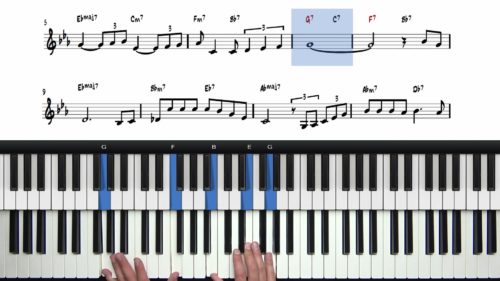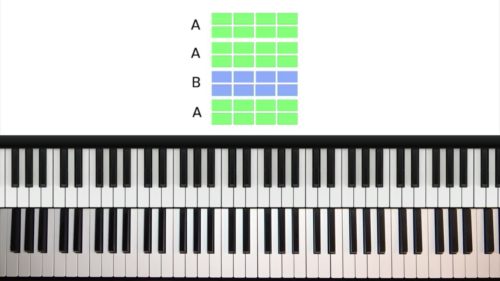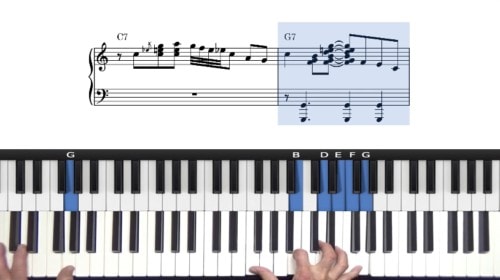Turnarounds For Beginners
In this lesson we introduce the concept of the turnaround. The turnaround is typically the final two bars in the blues form and it’s used to lead smoothly and convincingly back to the top of the form.
Why Is The Turnaround Important?
Well, the blues is a cyclical chord progression in the sense that it is repeated many times during a single performance and so smoothly transitioning back to the top of the form is an important skill.
If we play the exact same turnaround voicings each time we arrive at the end of the form, our playing can start to sound repetitive and so this module will teach you many variations and permutations of the turnaround.
Left Hand Embellishments
We have several options in the left hand when playing turnarounds. One option is simply to play single bass notes walking up from the I to the V chord. Notice the chromatic passing tone "B" between the IV and the V chords:

We can also play octaves in the bass for a thicker sound and grace notes can be used to add ornamentation and additional interest to our left hand. All of these techniques can then be combined to create interesting turnaround passages.
Blues Turnaround Variations
There are a potentially infinite number of ways that we can navigate the turnaround section of the blues. In this lesson we start with a the most basic turnaround examples. Another useful movement is descending 3rd in the right hand melody:

In the next lessons we explore a range of options and techniques that incorporate blues scales, extended chords, altered chords, gospel chord progressions, and more.
Lesson Downloads
-
Basic Blues Turnarounds File Type: pdf
Practice Tips
-
The turnaround sequence typically incorporates both chromatic and step-wise bass line movement from the I chord to the V chord.
-
Try to visualise the ascending bass line and outline this movement with single note bass, octave bass, and also add embellishments using grace notes.
-
Familiarise yourself with the different options that we have for the V7 chord in bar 12. The F/C moving to C7#5 can be used, or alternatively the descending line using 3rd intervals.
-
Start a habit of spontaneously choosing between these subtle turnaround variations to add more interest and variety to your blues piano playing.
- Once you are comfortable with the basic versions of the turnaround outlined in this lesson, move onto the next lessons in this module.








Hello (from France) , 2weeks on this site, i started blues and jazz beginner courses. Would you have a suggestion on what order to follow lessons, i have gone form the first one to this first turn around course on bleus… but following other turnarounds might be a lot, can i look further at leading tones for exemple or stick to this order ?
Thanks for you reply.
Hi Nicolas,
Thanks for getting in touch.
There is no ‘set-in-stone’ path to follow the lessons, but here is some guidance for you:
The Lead Sheet Fundamentals learning path – pianogroove.com/syllabuses/lead-sheet-fundamentals/ – will teach you basic jazz arrangement skills such as taking triads and 7th chords and voicing them as two-handed spread voicings. If you’re new to reading lead sheets I recommend to learn the songs in this learning path as we cover the same songs in the more advanced jazz courses.
For Blues, I recommend starting with the Slow Blues In F Course – pianogroove.com/blues-piano-lessons/slow-blues-piano-for-beginners/. This course incorporates a wide range of jazz theory, including chord extensions, chord alterations, passing chords, substitutions, and many other jazz elements.
If you want to skip over some of the turnaround lessons, that’s fine. You can revisit them later.
Yes you can absolutely move onto the leading tones lesson. Each lesson is a ‘mini-study’ and whilst I did design the course to be studied in this order, it’s fine to choose the lessons that interest you most.
I also created a slow blues course in the key of C which you can find here: pianogroove.com/blues-piano-lessons/slow-blues-piano-for-beginners/ – I think it’s nice to learn the blues in 2 different keys and see how the techniques are transferable.
—–
For jazz theory, the Essential Jazz Harmony Learning Path, – pianogroove.com/syllabuses/beginners-jazz-syllabus/ – contains a significant chunk of beginner and intermediate level jazz theory.
There is a lot of theory in this learning path which take many months to multiple years to fully assimilate, depending on your current level. So please understand that this is a gradual process. It’s not something that happens overnight, but by following this learning path you will find all of this theory laid out in a logical, step-by-step format.
——
I recommend that you broadly split your time 50% on the blues lessons and 50% on jazz lessons and that way you are working on both styles.
The jazz theory is applied in my blues piano courses and so the theory is very much interrelated between the courses on the website.
I hope that helps Nicolas, and if you have any other questions please let me know and I’m happy to help.
Best,
Hayden
Ok thanks, i am on the right path then. It’s good you say we don’t have to understand everything allready because even in the beginner’s study, there is a lot of information!
Hi Nicolas,
Yes that’s exactly correct.
Jazz theory is a vast subject – compare it to learning a language – and so it does takes time to fully absorb the material.
As you progress through the different courses on the PianoGroove website you will see the same theory areas and harmonic devices being used and developed.
Turnarounds for example are present in every jazz standard (typically the last 2 of each 8-bar section) and so as you learn more jazz standards you will encounter different chord voicings that we can use and different techniques to navigate these common progressions.
Make sure that you are not spending all of your time on the theory lessons, as it can quite quickly become overwhelming.
Instead divide your time between jazz standards, jazz theory drills, and also the blues as you have an interest in playing blues piano.
For example if you have 1 hour to practice each day, you could spend 20 minutes on each of these 3 areas. Repeat daily.
—-
You might also find these seminars useful where I explain the main theory areas for beginner and early-intermediate jazz studies and how it is applied to jazz standards:
pianogroove.com/live-seminars/how-what-to-practice/ (this is more theory related)
pianogroove.com/live-seminars/jazz-voicings-for-beginners/ (here showing how the theory is applied so that you can see the result of following the drills)
In these seminars, I am essentially explaining the “Essential Jazz Harmony Syllabus” and showing the exact drills and how the theory is used in practice.
These seminars are long (around 1 hour) but after watching them you will have a clear ‘birds eye view’ of the main theory milestones that lie ahead.
—–
The key is consistent practice Nicolas.
I recommend students to spend at least 1 hour a day, ideally 2 hours per day, and split this practice time into chunks of 20 minutes where you focus on a different topic or different song.
After a few weeks of spending just 20 minutes per day on a theory topic or jazz standard, you will see very noticeable improvements.
—–
Don’t hesitate to get in touch if you have any further questions.
Cheers,
Hayden